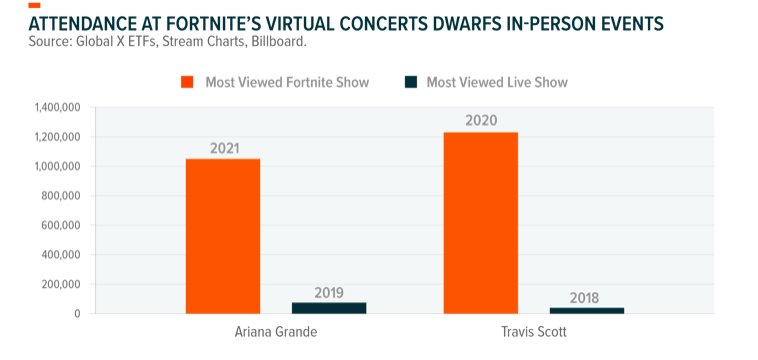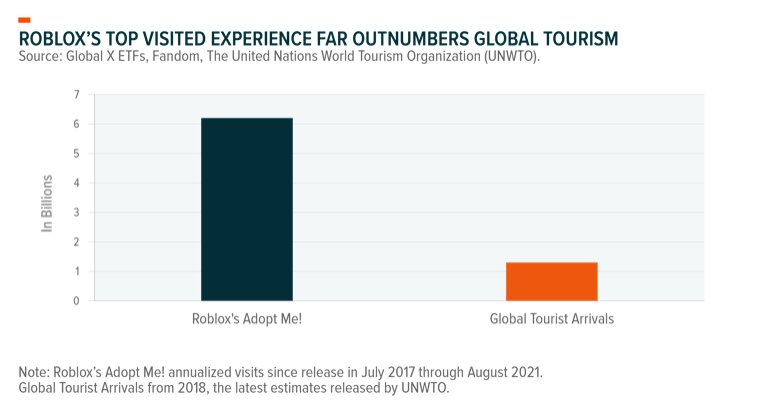By Pedro Palandrani, research analyst with Global X ETFs
On Facebook’s Q2 2021 earnings call, CEO Mark Zuckerberg and others mentioned the metaverse 20 different times. Roblox mentioned the metaverse 16 times on its call and Unity Technologies did so 8 times. Why are leading social media and video game companies so enamored with this term? It’s because many expect the metaverse to emerge as the next evolution of the internet, presenting trillions of dollars of opportunities, as well as risks, to today’s leading platforms and internet giants.
But what is the metaverse and why is it the likely successor to today’s internet? And which themes and segments are best positioned to benefit from this evolution? We’ll discuss these questions in this piece as we explore the metaverse and envision how it could drastically reshape the future.
Key Takeaways
- The metaverse is the next evolution of the internet, one that users are immersed and virtually present in. The metaverse consists of several key features including real-time persistency, economies, communities, digital avatars, and accessibility across multiple devices.
- Early versions of the metaverse exist today, offering investors a glimpse of its enormous potential. But a successful metaverse in the future is expected to feature a decentralized, open architecture platform accessed by virtual reality headsets and powered by blockchain technology.
- The concept, if successful, is expected to yield trillions of dollars of opportunities for companies stemming from several themes, including Social Media, Video Games, E-commerce, and Blockchain.
Defining the Metaverse
In today’s internet, we often access different digital platforms because they help facilitate physical-world experiences. We buy goods on Amazon that are shipped to our home, we share pictures on Instagram of our latest dinner out, or we buy tickets online to a concert at Madison Square Garden that we attend with friends.
In the metaverse, digital platforms will contribute largely to digital-world experiences. By jumping into an immersive experience using a virtual reality headset, one can work, play video games, buy digital items, socialize with friends, and consume media, all while present within the metaverse itself. Succinctly, Facebook’s Zuckerberg describes the metaverse as a virtual environment where you can be present with other people in digital spaces.
Broadly, we identify six main characteristics that define a metaverse:
- Identity: While digitally present in the metaverse, users can express themselves as whoever or whatever they want to be with their own avatar. To quote the science-fiction film Ready Player One, which depicts an infinite metaverse called the Oasis: “People come to the Oasis for all the things they can do, but they stay for all the things they can be: tall, beautiful, scary, a different sex, a different species, live action, cartoon, it’s all your call.”
- Multi-device: The ability to access the metaverse from anywhere is a key feature, whether it’s your phone, PC, tablet, or other devices. One of the biggest leaps forward will likely be the immersive virtual reality (VR) experience, which uses a head-mounted display to engulf users in a computer-generated environment where they can manipulate virtual objects. But lighter versions of the metaverse can exist too, via traditional screens and devices.
- Immersive: A truly immersive experience engages all of a person’s senses: sight, hearing, touch, smell, and taste. Today, VR mostly involves surround sound and images. The next generation of VR devices could include haptic bodysuits and omnidirectional treadmills that give users physical sensations through electro-stimulation as they navigate a digital environment.
- Economy: A fully developed metaverse has a functioning economy where users can earn and spend in digital or fiat currencies. An early example of a metaverse with an online economy is the gaming platform Roblox and its currency, the Robux. Users who purchase Robux can spend it on experiences and items for their avatar. Developers and creators can earn Robux by building engaging experiences and compelling items that users want to purchase, and converting those Robux back into fiat currencies like the US Dollar.
- Community: Users are not alone in the metaverse, but surrounded by others in real time, sharing experiences, and or interacting with one another. Using video games as an early predecessor of the metaverse, we have seen that enabling social experiences seems to be a core trait of successful titles. Activision Blizzard CEO Rob Kotick mentioned that players who play in groups with friends spend over three times more hours in the game and invest roughly three times more on in-game content compared to other players.1
- Real-time Persistent: The metaverse is expected to be real-time persistent with no ability to pause it. It continues to exist and function even after users have left. This trait shifts away the centricity of the user to the virtual world itself.
Early Days of the Metaverse Show Its Potential
The metaverse is not some futuristic idea; early versions already exist. Epic Games’ Fortnite has hosted virtual concerts with Ariana Grande and Travis Scott, where users attended as their digital avatars to enjoy the shared experience with others. The success of these events has been staggering, drawing millions of fans that far outnumbered in-person shows.

Similarly, Roblox’s popular experience Adopt Me! counts 6.2 billion annual visits on average since its release in July 2017.2 And Adopt Me! is just one of the thousands of places available to visit in Roblox’s platform. To the extent that traveling in virtual worlds and the real world are quasi-comparable, the metaverse could become an economical form of on-demand mass transit to explore new places, people, and cultures. For comparison, pre-pandemic, international tourist arrivals around the globe totaled 1.4 billion annually.3 The city with the most annual international visits pre-pandemic was Bangkok with approximately 23 million.4

In August 2021, Facebook took a major step towards a metaverse offering when it unveiled “Horizon Workrooms,” a virtual meeting space where co-workers can interact with each other in the form of their digital avatars. Entering the workroom requires an Oculus VR headset and downloading the free app.
Each of these examples offer bits and pieces of what a full metaverse could ultimately look like. As companies invest further in building metaverse-related initiatives, it’s important to remember that what we call ‘the metaverse’ isn’t necessarily a centralized monopoly.
Metaverse development may yield more centralized and distinct experiences currently, but it’s working towards an end-state that is fully decentralized. And unlike in Ready Player One, which depicts a metaverse where the real world is left behind for one infinite virtual world, in our world several metaverses are likely to emerge.
To read this post in its entirety, click here and visit the Global X blog.
Photo Credit: Dako Huang via Flickr Creative Commons
FOOTNOTES
1. Activision Blizzard, “Q4 2020 Earnings Call,” Feb 4, 2021.
2. Fandom, “Roblox Wiki – List of places with the most visits,” Aug 28, 2021.
3. Our World in Data,” Tourism – International arrivals by world region,” accessed on Aug 30, 2021.
4. Mastercard, “Global Destination Cities Index 2019,” Sep 4, 2019.
Disclosure
Investing involves risk, including the possible loss of principal. Video Game and Esports Companies are subject to risks associated with additional regulatory oversight with regard to privacy/cybersecurity concerns, shifting consumer preferences, and potential licensing challenges. Investing in securities engaged in the social media industry or Information Technology includes risks, such as disruption in service caused by hardware or software failure; interruptions or delays in service by third-parties; security breaches involving certain private sensitive, proprietary and confidential information managed and transmitted by social media companies; and privacy concerns and laws, evolving Internet regulation and other foreign or domestic regulations that may limit or otherwise affect the operations of such companies. E-commerce companies may be subject to rapid changes in technology, intense competition, rapid obsolescence of products and services, loss of intellectual property protections, evolving industry standards and frequent new product productions, and changes in business cycles and government regulation. Investments in blockchain companies may be subject to the following risks: the technology is new and many of its uses may be untested; theft, loss or destruction of key(s) to access the blockchain; intense competition and rapid product obsolescence; cybersecurity incidents; lack of liquid markets; slow adoption rates; lack of regulation; third party product defects or vulnerabilities; reliance on the Internet; and line of business risk. Narrowly focused investments typically exhibit higher volatility. International investments may involve risk of capital loss from unfavorable fluctuation in currency values, from differences in generally accepted accounting principles or from social, economic or political instability in other nations. HERO, SOCL, EBIZ, and BKCH are non-diversified.



